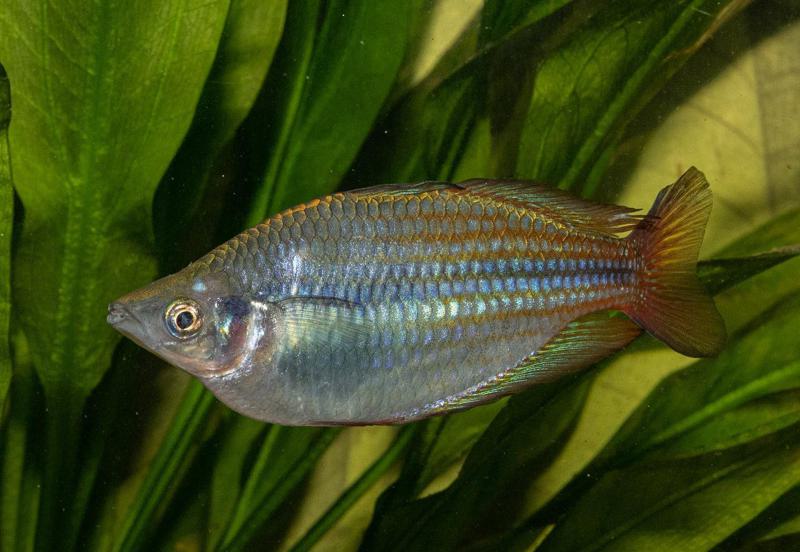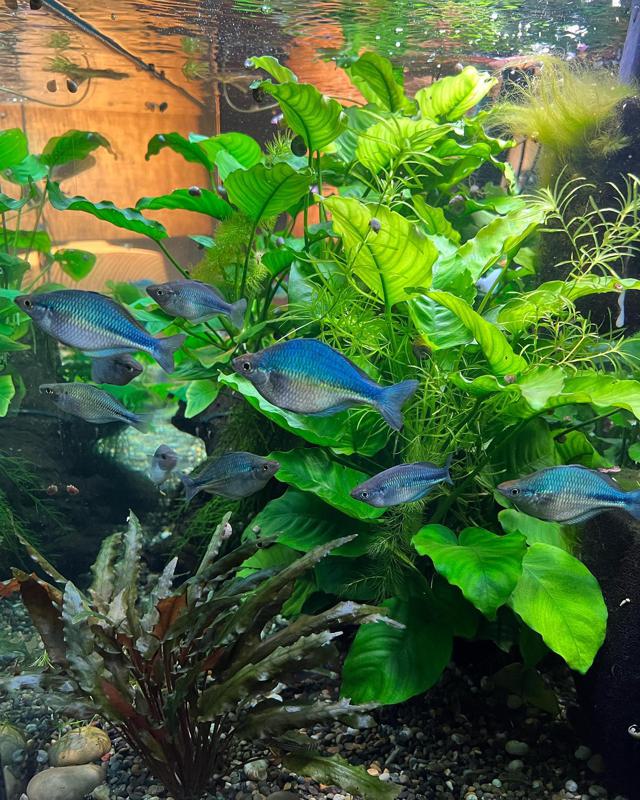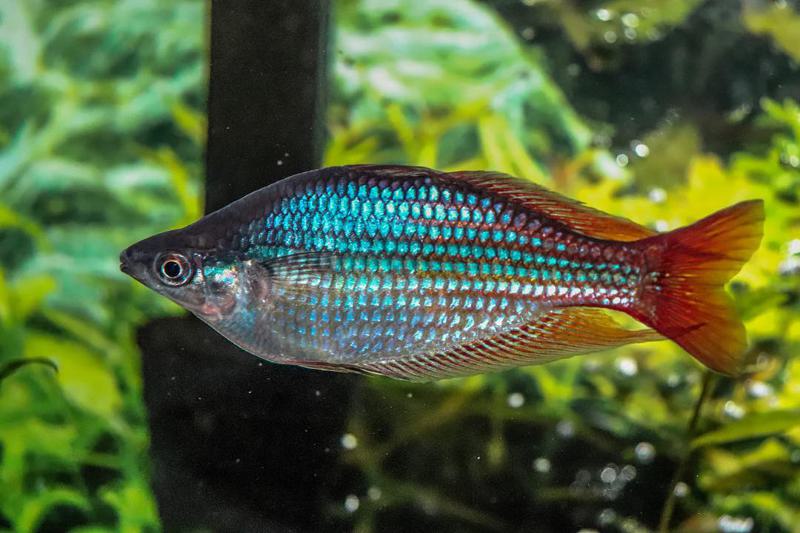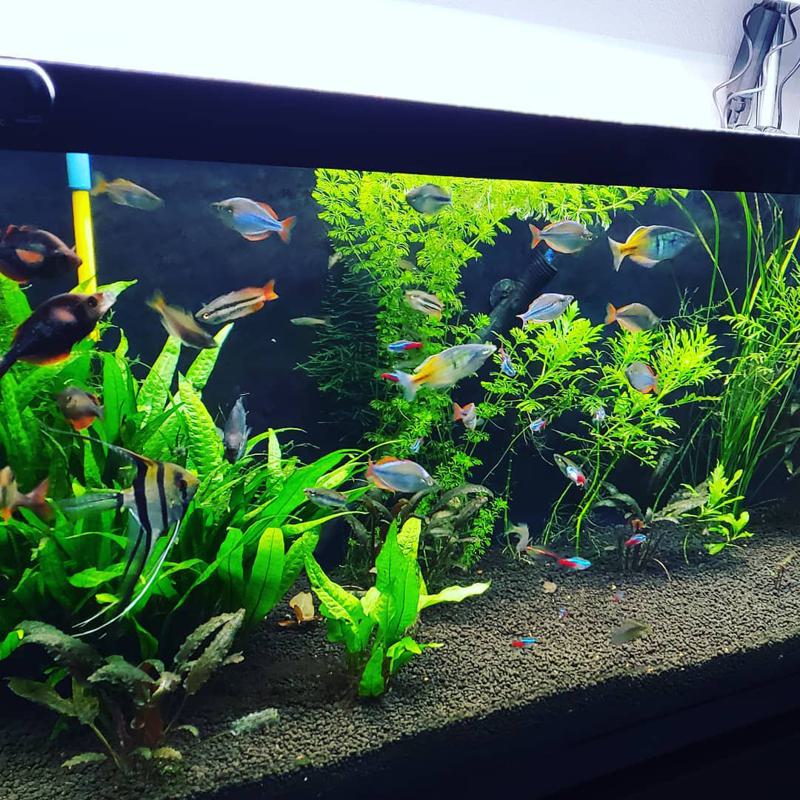Fish owners prefer to keep their tanks as vibrant as possible. The aesthetic attractiveness of aquariums is significant despite the fact that there’s a great deal of love for growing fish.
There are many different ways to add color to tanks. One option is to use lighting techniques and decorations. Also, some aquarists advise adding corals and live plants to the aquariums for aesthetic purposes.
Another way to make your tank more vibrant and colorful is to introduce Australian rainbow fish. Today, we will meet this lover species and find out more about it.
Keep reading to learn about its lifespan, care, diet, breeding, temperament, appearance, and size. We will also help you choose the best tankmates and much more.
What’s Australian Rainbow Fish?

Australian Rainbow Fish (or shortly Australian Rainbow) is known for its lovely colors. Both seasoned fishkeepers and beginners looking for colorful aquarium fish find it a valuable addition to their tanks.
Basic Facts about This Type of Fish
As a matter of fact, that’s a common name for numerous species of fish that are closely related. The species diversity is great. There are about 50 varieties around the world – they all belong to the genera Melanotaenia.
- Order: Atheriniformes
- Suborder: Atherinoidei
- Family: Melanotaeniidae
- Genera: Melanotaenia
Eastern rainbowfish (Melanotaenia Splendida) is one of the most popular and best-known species. Other popular Australian Rainbow species include:
- Axelrod’s Rainbowfish
- Boesemani Rainbowfish
- Banded Rainbowfish
- Celebes Rainbowfish
- Desert Rainbowfish
- Forktail Rainbowfish
- Madagascan Rainbowfish
- Neon Rainbowfish
- Red Irian Rainbowfish
- Threadfin Rainbowfish
They are all similar in terms of temperament, size, and shape. Furthermore, they are all popular with fishkeepers thanks to their magnificent bright colors.
What’s Their Natural Habitat?
Remember that they’re schooling fish. This means they are arranging themselves in large groups in nature (rivers, ponds, streams, swamps, lakes, etc).
They are usually found near river banks with slow currents and ample vegetation. This is a kind of fish that inhabits places under floating plants, submerged logs, as well as different underwater structures.
But you don’t have to go to Australia to catch them in nature. They are available online and in many pet fish stores.
Australian rainbow fish are also produced commercially and grown for sale on many farms in Florida and Southeast Asia. So, they can be found in aquariums around the world.
Their harvesting for the purpose of fishkeeping happens yet. It comes as no surprise considering that a great number of hobbyists want to settle down Australian Rainbow in their tanks.
This type of fish tends to create groups or communities in freshwater aquariums, too.
Did we catch your interest? Would you like to find out more about Australian Rainbow Fish? Read on for more facts!
Appearance and Size

Looks
The color is no doubt the top reason why most people choose Australian rainbow fish. The majority of people purchase it to add colors to their aquariums in the first place.
Australian rainbow fish is famous for its beautiful color hints. On their silver bodies, there could be a full spectrum of shades and hues, including bright purple, blue, red, orange, green, and yellow.
During breeding, mature fish display their brightest colors. Aside from a colorful body, it features an elongated body with a deeply forked mouth and big eyes.
Their bodies are flattened on either side and have 2 dorsal fins. The lavishly appointed fins are very striking and they add to their attractiveness and beauty.
A dark silver or black band is running through the central-scale rows, making their broad body even more appealing. Older males have somewhat humped bodies and backs.
Size
As for the size, Australian rainbow fish may get relatively big, reaching 10 centimeters. Nonetheless, it might not be the largest fish in your aquarium.
Their maximum size is 4 inches (around 10 cm) under ideal conditions. It is worth mentioning that not every species or subspecies can reach that size. Most of them grow up to 2 inches (about 5 cm).
Make sure your tank has sufficient capacity to accommodate them in a convenient way. The more fish you add, the greater tank should be.
This is important because the Australian Rainbow is busy fish that’s on the move at all times, exploring the surrounding environment.
Australian Rainbow Fish Care

Easy care, besides its awe-inspiring appearance, is what makes the Australian Rainbow popular with many fishkeepers. No special care is required. Compared to other fish types, Australian rainbow fish is not demanding either.
Plus, it is also adaptive to different environments and can withstand a wide variety of water parameters. That makes it great for beginners or people who are new to fishkeeping.
Australian rainbow fish can survive even in harsh conditions by adapting to just about any freshwater environment. That’s not to say you shouldn’t care for them.
They would enjoy a freshwater tank with plenty of live plants. For substrate, you should consider using 3-4 inches of fine gravel or aquarium sand. That would serve the purpose of anchoring plants just fine.
A combination of anchored and floating plants will be appreciated by your fish. Complete the tank environment with a few pieces of logs (either artificial or natural) and several rocks. Australian Rainbow Fish will enjoy it!
Water Change & Quality
Water quality matters. It can make a difference in the health and well-being of your fish.
Use a top-quality filter to keep the water clean. The tank water is also supposed to be balanced and chemical-free.
Additionally, partial water replacement is important alike. It should be performed regularly every 7 or 14 days.
You are advised to change out 25% of the water every other week. If you prefer to do it once a week, then 15% would be enough.
While Australian rainbow fish has no special requirements, this doesn’t mean they can thrive well in any aquarium.
Tank Size
Australian Rainbow Fish thrives well in planted tanks with gravel substrates when kept in groups of 7 or more. They prefer spacious aquariums with sufficient places for swimming.
They need aquariums of 20-50 gallons for easy accommodation. This depends on how many individuals you want o introduce in your aquarium.
For example, a 50-gallon tank will be quite sufficient for a school of 8 fish. But if you want to keep more than ten Australian Rainbow Fish and add tank mates as well, you need to consider larger aquariums of 100 gallons.
Other Requirements: Temperature, pH Levels, Hardness
In addition to the tank size, you should strive to provide other conditions that meet the Australian Rainbow’s requirements. It’s necessary for the best health of your fish.
The pH level of water should be maintained in such a way that it is always anywhere from 6.0 to 7.5. It’s best to keep it between 6.5 and 7.2 all the time.
When it comes to the hardness of the water, it needs to be from 3 to 25 DH. Australian Rainbow Fish prefer soft to medium water.
The water temperature should be between 72°F and 82°F for optimal health. They can withstand changing temperatures.
So, even if you make a mistake resulting in a sudden shift in the water temperature, your fish is likely to survive as long as these changes are not extreme.
Likewise, they can adapt to low temperatures in nature. Australian rainbow fish don’t need to migrate in winter because they can continue living in cold locations.
Even so, make sure the water temperature in your tank is not lower than 70°F. This is especially true during the breeding period when their good health is of crucial importance for reproduction.
Ideally, it needs to be between 74°F and 78°F. By the way, cold water (below this ideal temperature range) can cause rainbow fish to become sluggish while losing color and weakening over time.
That eventually results in disease. The most common types of illnesses Australian rainbow fish suffer from in aquariums include Velvet and White Spot Disease.
What Do Australian Rainbow Fish Eat?

It is critical to provide your fishy friends with the right food based on their intake preferences. Australian rainbow fish follow an omnivorous diet.
Timely and proper feeding sessions will make sure your aquarium pets are not underfed. They have to be fed in an adequate manner to have a colorful and joyful aquarium.
Type of Food to Include in Their Diet
As omnivores, Australian rainbow fish eat both meat- and vegetable-based food. So, you can give them everything from plant matter and flakes to live and frozen food.
Here are some commercial food products Australian rainbow fish like to eat:
- Aqueon Tropical Flakes
- Spirulina Flakes
- Color Flakes
- Betta Treat
Consider using pellets and tablets besides vegetable substances and meaty food. Combine 25% meaty food with 75% flake food.
We recommend including live “natural” food in their diet as well. This will help you come up with the most suitable food pattern. Below are some of their favorite treats:
- Chopped earthworms
- Chopped blood worms
- Brine shrimp
- White worms
Feeding Pattern
Feeding them is easier than many people think. That’s because they consume a diverse range of foods. Australian Rainbow Fish take most of the food on the water surface.
When feeding your fish, make sure the food items can be consumed in no more than five minutes. Why does it matter?
If food is left untouched for more time, it might end up going to waste. That leads to increased ammonia levels and toxicity.
The suggested feeding pattern involves providing food twice or once a day. In case your fish eat food fast, think of increasing the feeding frequency and reducing the quantity.
Breeding and Reproduction
If you want to breed Australian Rainbow Fish, remember that they are egg scatters (or egg layers), so a separate tank is necessary for the sake of breeding. Equip it with a high-quality filter to provide ideal water conditions for breeding.
Do not mix subspecies. Thus, you may end up producing dull fish that lack bright colors.
We recommend adding moss substrate (Java moss). That can encourage reproduction by making it easier for rainbow fish to catch their eggs.
When the males display their brightest colors, the courtship starts in aquariums. That means everything is ready for a love spell.
As it turned out, male fish get more attractive and careful with age. That’s because they wish to entice females for mate-seeking motives.
Females release hundreds of tiny eggs at a time. Once the females have laid their eggs above vegetation, male fish will fertilize them shortly.
After reproduction, females lay a lot of small eggs on the substrate. The fry starts hatching after 6-7 days at the water temperature of 75°F.
Be sure to remove adults from your breeding tank after that to prevent them from eating young fish. The fry feed on the yolk sac right after hatching.
After 24-32 hours, you should provide them with a diet consisting of plant matter, flakes, and live foods. As mentioned earlier, stick to an omnivorous diet for the best results.
Maintaining a healthy combination of males and females is important all the while. This will ensure that they live peacefully in the congregation.
As a general rule of thumb, there should be a minimum of three female fish for every male. Such a ratio is important for reducing aggression and pestering in the fish community. Moreover, this will make your aquarium look more impressive.
Australian Rainbow Fish Tank Mates

If you want to add Australian rainbow fish to your aquarium, then you’re probably concerned about whether their tank buddies are compatible. You don’t want any troubles in your tank, right?
Don’t worry. It’s compatible with various species and doesn’t attack other fish in tanks. That will allow you to pick and choose different aquarium buddies and select a variety of combinations.
Despite great compatibility, you should not pick random tank mates for your Australian rainbow fish. That’s because some plants and types of fish might be disrupting their existence and growth.
Suitable tankmates include other types of rainbow fish that have a similar size and peaceful temperament. You can also mix them with barbs, danios, characins, rasboras, corydoras, goldfish, and catfish.
More specifically, we recommend the following species of fish as tank mate choices:
- Kribensis Cichlid
- Bristlenose Pleco
- Pearl Gourami
- Dwarf Gourami
- Silver Dollars
- Cardinal Tetra
- Rosy Tetra
Species that should be avoided as Australian rainbow tank mates include Paradise Gourami, Kissing Gourami, Cichlids, and Oscars.
You want to create a perfect community in your aquarium. It should consist of an adequate number of Australian rainbow fish to avoid potential problems.
Apart from that, the female-male ratio has to be optimal in the aquarium. Otherwise, you will run into issues with their reproduction during the breeding period.
Related: Types of RainbowFish
FAQs
Why Are They Called Australian Rainbow Fish?
As you can guess from its name, this type of fish is native to Australia. However, they can also be found in Indonesia and Papua New Guinea in nature.
These rather active fish boast a colorful body with various skin colors, which resembles a rainbow – hence the second part of the name.
Are Australian Rainbow Fish Aggressive?
No, they are not. Australian rainbowfish are generally peaceful and their temperament is relaxed. That means you can put them in your tank alongside other fish species without any hitch.
However, it should be noted that Australian rainbow fish can be extremely active in aquariums. With its relatively large size and rapid movements, it may disturb slow-moving or smaller fish.
While they don’t remain idle in tanks, they don’t cause trouble and aren’t aggressive at all. The nature of Australian rainbow fish is quite dynamic.
That’s why your tank may become very active when mixing them with other fish. Be ready for this!
What’s the Lifespan of Australian Rainbow Fish?
The lifespan of Australian Rainbow Fish is relatively high. In general, they live from five to eight years with proper care, provided that the aquarium conditions are favorable and their diet is appropriate.
While the average lifespan is 5-6 years, they can turn 8 years in well-maintained tanks sometimes. It depends largely on their genetics and health condition.
As an owner of these beautiful fish, you should aim to create the finest growing environment for them. That will boost their odds of living for many years. Do everything in your power to increase their lifespan!
Conclusion
Now that you’ve gone through this guide, you should have a better idea of what Australian rainbow fish are and what they require. Use these guidelines and facts when taking care of them in your tank.
As you can see, they are not difficult to take care of. Australian rainbow fish can grow and thrive impressively with the proper diet pattern and favorable tank environment. Expect them to live 5-8 years with adequate care.
Ensure that your “rainbows” have a suitable environment for the best growth and reproduction. Last but not least, make sure they share the aquarium with compatible tank mates to avoid trouble.